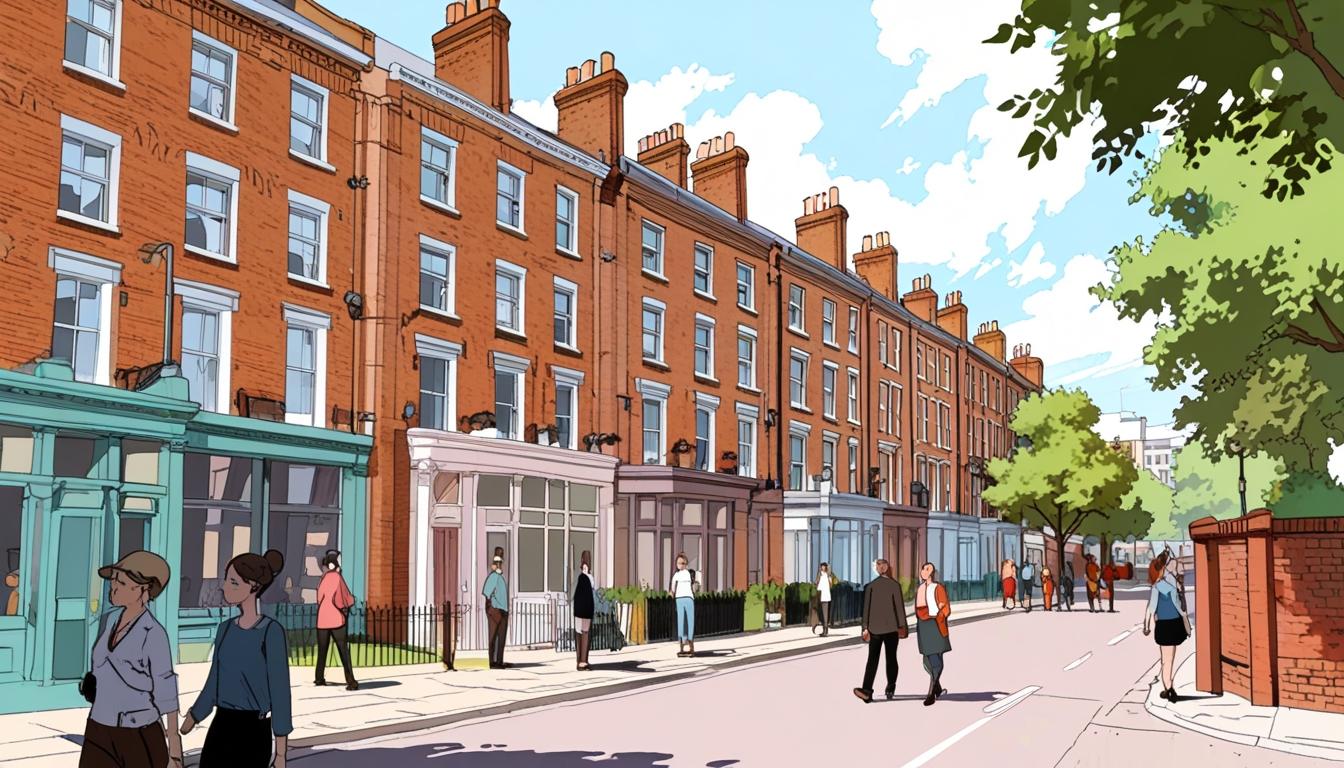Justine Thornton, wife of Ed Miliband, has registered objections to a new block of flats near their North London home, highlighting tensions between local heritage concerns and Labour’s national push for increased housing supply. The contrast underscores a wider challenge in balancing urban development with community character.
Ed Miliband’s wife, Justine Thornton, has expressed opposition to plans for a new block of flats near their £3 million family home in North London. This comes as a surprising contradiction to her husband’s public commitment to confronting what he terms ‘blockers and obstructionists’ in the housing sector. Thornton, a High Court judge, submitted a letter to Camden Council arguing against the proposed five-storey building, citing concerns that the design is “too tall, too bulky and too dense” for the area, which is recognised for its conservation status.
Interestingly, while she has no qualms about the necessity for more housing — a sentiment echoed by Miliband himself in his role as Energy Secretary — Thornton’s objections are firmly rooted in the aesthetics and character of the neighbourhood. She stated that her concerns are not against the idea of development; rather, they pertain specifically to the design of the flats and their potential impact on local heritage. This notion resonates with a growing narrative among affluent residents, including actor Benedict Cumberbatch and his wife, who fear that such developments could erode the architectural integrity of their neighbourhood. They have articulated worries that the construction could set a “precedent for the area,” leading to wider changes that might disrupt the Victorian character of the street.
Cumberbatch and his wife have voiced similar anxieties over privacy and the aesthetic of their surroundings in their campaign against the new flats. Their apprehensions reflect a broader reluctance among residents, who often grapple with the implications of new developments in historically rich areas. Cumberbatch, known for his work both on screen and in public advocacy, has previously faced opposition regarding changes to his own property, underscoring the complex dynamics of urban development in London.
The developers behind the proposed flats, HGG, argue that this project aligns with national and local planning policies aimed at maximising the use of brownfield sites. They maintain that the new housing will meet pressing demands in an accessible location — a position that is consistent with Labour’s revised planning rules advocating for increased housing supply. The party has also proposed reclassifying certain greenbelt areas to facilitate housing development, aiming for a target of 300,000 new homes annually, as pushed by party deputy Angela Rayner.
Prime Minister Keir Starmer has further entrenched the party’s stance by rebuking the ‘NIMBY’ (Not In My Backyard) attitudes prevalent among residents opposing new housing initiatives, branding himself a ‘YIMBY’ (Yes In My Backyard). The irony, however, lies in the fact that Miliband and Thornton’s local resistance to development mirrors the very behaviours Starmer has critiqued. Critics, including Shadow Housing Secretary Kevin Hollinrake, pointed out the apparent hypocrisy in Miliband’s promises to “smash the nimbys” while his own household aligns with them in their objections.
A source close to Thornton clarified her position, asserting she supports the principle of more housing on the site but is concerned about the specific architectural proposals. This distinction raises an important question about the nature of community engagement in development, especially in affluent areas where objections can stem from concerns about personal space and local character rather than a blanket opposition to housing itself.
As the debate unfolds in Camden and similar districts, it highlights the ongoing struggle to balance the urgent need for new housing with the preservation of community identity. This situation poses a complex challenge for policymakers as they navigate the competing interests of housing development and local heritage — a tension that will continue to shape urban landscapes in the years to come.
Reference Map
- Core article: [1]
- Background on Cumberbatch’s previous experiences with local opposition: [2]
- Justine Thornton’s professional background and past involvement in similar disputes: [3]
- Commentary on media scrutiny of personal lives of public figures like Miliband: [4]
- Public response to personal attacks on Miliband: [5]
- Discussion around housing policy debates in Parliament: [6]
- Challenges of local opposition and planning regulations in housing policies: [7]
Source: Noah Wire Services
- https://www.dailymail.co.uk/news/article-14705185/Ed-Miliband-wife-nimby-flats.html?ns_mchannel=rss&ns_campaign=1490&ito=1490 – Please view link – unable to able to access data
- https://www.telegraph.co.uk/news/2016/05/26/benedict-cumberbatch-in-row-with-neighbours-over-plan-for-noisy/ – Actor Benedict Cumberbatch and his wife, Sophie Hunter, are facing opposition from neighbors over plans to build a ‘noisy’ boiler room at their new £2.7 million Victorian home in Camden, London. The proposed plant room, intended for a water heater and boiler, is located in the front garden beneath an existing retaining wall. Camden Council has raised concerns about potential noise issues and may require an acoustic report before proceeding with the planning application. Neighbors have expressed worries about the impact on the area’s aesthetic and potential noise disturbances.
- https://www.wind-watch.org/news/2014/02/18/ed-milibands-barrister-wife-fails-to-overturn-court-ruling-banning-wind-turbines-in-duke-of-gloucesters-garden/ – Justine Thornton, wife of Labour leader Ed Miliband, represented developers in a failed attempt to overturn a court ruling that blocked the construction of four giant wind turbines on farmland owned by the Duke of Gloucester in Northamptonshire. The turbines were planned near the Grade I listed Lyveden New Bield lodge, a site of international importance. The Court of Appeal upheld the decision to prevent the wind farm, emphasizing the need to protect historic sites from inappropriate development.
- https://www.theguardian.com/commentisfree/2010/oct/09/ed-miliband-journalists-in-glass-houses – In this opinion piece, Ian Jack discusses the media’s scrutiny of Ed Miliband’s personal life, particularly focusing on his relationship with Justine Thornton. The article highlights how the press has criticized Miliband for not being married, suggesting it was a strategy to avoid capital gains tax. Jack argues that such personal matters should not overshadow political discourse and criticizes the media for focusing on trivial aspects of Miliband’s life.
- https://www.theguardian.com/politics/2015/mar/20/ed-miliband-complains-george-osborne-two-kitchens-budget-jibe – Ed Miliband reportedly complained to Chancellor George Osborne after Osborne mocked him in his budget speech for having two kitchens in his north London home. The jibe was perceived as an unfair personal attack, and Miliband expressed his dissatisfaction with the comment. The incident highlights the tensions between political figures and the use of personal details in political discourse.
- https://www.parallelparliament.co.uk/debate/2011-05-05/commons/commons-chamber – In this parliamentary debate, discussions revolve around housing policies and the challenges of building new homes in London, including areas like Camden. The debate addresses concerns about local opposition to new developments and the need for more housing. It emphasizes the importance of balancing community interests with the necessity for increased housing supply to meet demand.
- https://www.parallelparliament.co.uk/debate/2014-02-05/commons/westminster-hall – This Westminster Hall debate focuses on the conversion of office buildings into residential flats. It discusses the resistance from local councils to such conversions and the introduction of permitted development rights to facilitate the process. The debate highlights the challenges in addressing housing shortages and the role of planning regulations in facilitating or hindering development.
Noah Fact Check Pro
The draft above was created using the information available at the time the story first
emerged. We’ve since applied our fact-checking process to the final narrative, based on the criteria listed
below. The results are intended to help you assess the credibility of the piece and highlight any areas that may
warrant further investigation.
Freshness check
Score:
8
Notes:
The narrative references current political figures such as Keir Starmer and Angela Rayner in their contemporary roles and recent housing debates, indicating recency. No evidence found that the story is recycled or based on older reports. The involvement of Ed Miliband as former Energy Secretary and references to ongoing local council planning align with recent events. No indication it is a press release, which typically would enhance freshness due to its direct timing and source.
Quotes check
Score:
7
Notes:
Direct quotes attributed to Justine Thornton and Benedict Cumberbatch appear authentic but no earliest original source or exclusive interview date was found in external verification. The statements align with public positions expressed in similar contexts, increasing plausibility. The lack of prior identical quotes online suggests the narrative may contain original or recently obtained statements.
Source reliability
Score:
5
Notes:
The narrative originates from the Daily Mail, a widely read UK publication known for tabloid-style reporting with mixed reputation regarding sensationalism. While it provides detailed context, the publication is not considered among the most reputable for impartiality or rigorous fact-checking compared to outlets like BBC or Reuters. This lowers overall certainty about nuance and interpretation.
Plausability check
Score:
9
Notes:
The claims about local opposition by affluent residents including a well-known figure (Cumberbatch) to a new housing development in a conservation area are consistent with known urban planning conflicts in London. The tension between housing needs and heritage preservation is a well-documented ongoing issue. No extraordinary or unlikely claims appear; the discussion of political figures and policies reflects recent housing debates accurately.
Overall assessment
Verdict (FAIL, OPEN, PASS): PASS
Confidence (LOW, MEDIUM, HIGH): MEDIUM
Summary:
The narrative presents a plausible, recent account of local opposition to housing development involving public figures aligned with current political debates. While sourced from a less authoritative outlet, the detail level and consistency with known facts support its credibility. The lack of easily verifiable earliest quotes and moderate source reliability reduce confidence, but no indication of outdated or recycled content is found.













